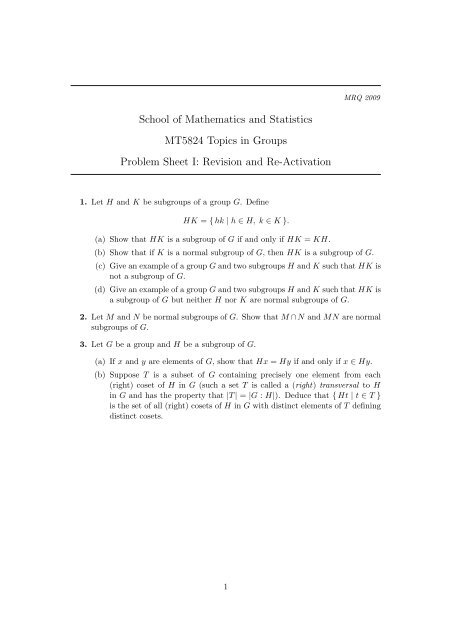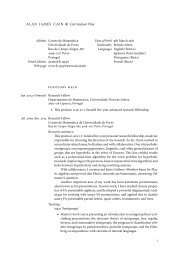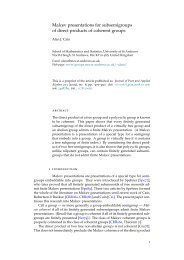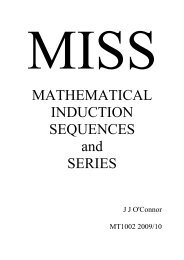Problem Sheet I
Problem Sheet I
Problem Sheet I
Create successful ePaper yourself
Turn your PDF publications into a flip-book with our unique Google optimized e-Paper software.
School of Mathematics and Statistics<br />
MT5824 Topics in Groups<br />
<strong>Problem</strong> <strong>Sheet</strong> I: Revision and Re-Activation<br />
1. Let H and K be subgroups of a group G. Define<br />
HK = { hk | h ∈ H, k ∈ K }.<br />
(a) Show that HK is a subgroup of G if and only if HK = KH.<br />
MRQ 2009<br />
(b) Show that if K is a normal subgroup of G, then HK is a subgroup of G.<br />
(c) Give an example of a group G and two subgroups H and K such that HK is<br />
not a subgroup of G.<br />
(d) Give an example of a group G and two subgroups H and K such that HK is<br />
a subgroup of G but neither H nor K are normal subgroups of G.<br />
2. Let M and N be normal subgroups of G. Show that M ∩N and MN are normal<br />
subgroups of G.<br />
3. Let G be a group and H be a subgroup of G.<br />
(a) If x and y are elements of G, show that Hx = Hy if and only if x ∈ Hy.<br />
(b) Suppose T is a subset of G containing precisely one element from each<br />
(right) coset of H in G (such a set T is called a (right) transversal to H<br />
in G and has the property that |T | = |G : H|). Deduce that { Ht | t ∈ T }<br />
is the set of all (right) cosets of H in G with distinct elements of T defining<br />
distinct cosets.<br />
1
4. Let G be a (not necessarily finite) group with two subgroups H and K such that<br />
K � H � G. The purpose of this question is to establish the index formula<br />
|G : K| = |G : H| · |H : K|.<br />
Let T be a transversal to K in H and U be a transversal to H in G.<br />
(a) By considering the coset Hg or otherwise, show that if g is an element of G,<br />
then Kg = Ktu for some t ∈ T and some u ∈ U.<br />
(b) If t, t ′ ∈ T and u, u ′ ∈ U with Ktu = Kt ′ u ′ , first show that Hu = Hu ′ and<br />
deduce u = u ′ , and then show that t = t ′ .<br />
(c) Deduce that TU = { tu | t ∈ T, u ∈ U } is a transversal to K in G and that<br />
|G : K| = |G : H| · |H : K|.<br />
(d) Show that this formula follows immediately from Lagrange’s Theorem if<br />
G is a finite group.<br />
5. Let G be a group and H be a subgroup of G.<br />
(a) Show that H is a normal subgroup of G if and only if Hx = xH for all<br />
x ∈ G.<br />
(b) Show that if |G : H| = 2, then H is a normal subgroup of G.<br />
6. Give an example of a finite group G and a divisor m of |G| such that G has no<br />
subgroup of order m.<br />
7. Let G = 〈x〉 be a cyclic group.<br />
(a) If H is a non-identity subgroup of G, show that H contains an element of<br />
the form x k with k > 0.<br />
Choose k to be the smallest positive integer such that x k ∈ H. Show<br />
that every element in H has the form x kq for some q ∈ Z and hence that<br />
H = 〈x k 〉. [Hint: Use the Division Algorithm.]<br />
Deduce that every subgroup of a cyclic group is also cyclic.<br />
(b) Suppose now that G is cyclic of order n. Let H be the subgroup considered<br />
in part (a), so that H = 〈x k 〉 where k is the smallest positive integer such<br />
that x k ∈ H, and suppose that |H| = m.<br />
Show that k divides n. [Hint: Why does x n ∈ H?]<br />
Show that o(x k ) = n/k and deduce that m = n/k.<br />
Conclude that, if G is a cyclic group of finite order n, then G has a unique<br />
subgroup of order m for each positive divisor m of n.<br />
(c) Suppose now that G is cyclic of infinite order. Let H be the subgroup<br />
considered in part (a), so that H = 〈x k 〉 where k is the smallest positive<br />
integer such that x k ∈ H.<br />
Show that {1, x, x 2 , . . .,x k−1 } is a transversal to H in G. Deduce that<br />
|G : H| = k. [Hint: Use the Division Algorithm to show that if n ∈ Z, then<br />
x n ∈ Hx r where 0 � r < k.]<br />
Conclude that, if G is a cyclic group of infinite order, then G has a unique<br />
subgroup of index k for each positive integer k and that every non-trivial<br />
subgroup of G is equal to one of these subgroups.<br />
2
8. Let V4 denote the Klein 4-group: that is V4 = {1, a, b, c} where a = (1 2)(3 4),<br />
b = (1 3)(2 4) and c = (1 4)(2 3) (permutations of four points). Find three distinct<br />
subgroups H1, H2 and H3 of V4 of order 2. Show that Hi ∩ Hj = 1 for all i �= j<br />
and V4 = HiHj for all i and j.<br />
[Note that I am using the more conventional notation V4 for the Klein 4-group,<br />
rather than the less frequently used K4 from MT4003. Here V stands for Viergruppe.]<br />
9. The dihedral group D2n of order 2n is generated by the two permutations<br />
α = (1 2 3 . . . n), β = (2n)(3n−1) · · · .<br />
(a) Show that α generates a normal subgroup of D2n of index 2.<br />
(b) Show that every element of D2n can be written in the form α i β j where<br />
i ∈ {0, 1, . . .,n − 1} and j ∈ {0, 1}.<br />
(c) Show that every element in D2n which does not lie in 〈α〉 has order 2.<br />
10. The quaternion group Q8 of order 8 consists of eight elements<br />
with multiplication given by<br />
1, −1, i, −i, j, −j, k, −k<br />
i 2 = j 2 = k 2 = −1, ij = −ji = k, jk = −kj = i, ki = −ik = j.<br />
(a) Show that Q8 is generated by i and j.<br />
(b) Show that 〈i〉 is a normal subgroup of Q8 of index 2.<br />
(c) Show that every element of Q8 can be written as i m j n where m ∈ {0, 1, 2, 3}<br />
and n ∈ {0, 1}.<br />
(d) Show that every element in Q8 which does not lie in 〈i〉 has order 4.<br />
(e) Show that Q8 has a unique element of order 2.<br />
3














